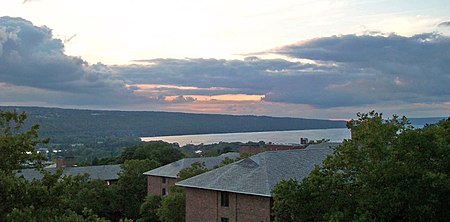Cayuga Lake
Anti-nuclear movement in the United StatesFinger LakesLakes of Cayuga County, New YorkLakes of New York (state)Lakes of Seneca County, New York ... and 4 more
Lakes of Tompkins County, New YorkTourist attractions in Cayuga County, New YorkTourist attractions in Seneca County, New YorkTourist attractions in Tompkins County, New York

Cayuga Lake (,,) is the longest of central New York's glacial Finger Lakes, and is the second largest in surface area (marginally smaller than Seneca Lake) and second largest in volume. It is just under 39 miles (63 km) long. Its average width is 1.7 miles (2.8 km), and it is 3.5 mi wide (5.6 km) at its widest point, near Aurora. It is approximately 435 ft deep (133 m) at its deepest point, and has over 95 miles (153 km) of shoreline.The lake is named after the indigenous Cayuga people.
Excerpt from the Wikipedia article Cayuga Lake (License: CC BY-SA 3.0, Authors, Images).Cayuga Lake
Geographical coordinates (GPS) Address Nearby Places Show on map
Geographical coordinates (GPS)
| Latitude | Longitude |
|---|---|
| N 42.688055555556 ° | E -76.702222222222 ° |
Address
Town of Ledyard
13026
New York, United States
Open on Google Maps


